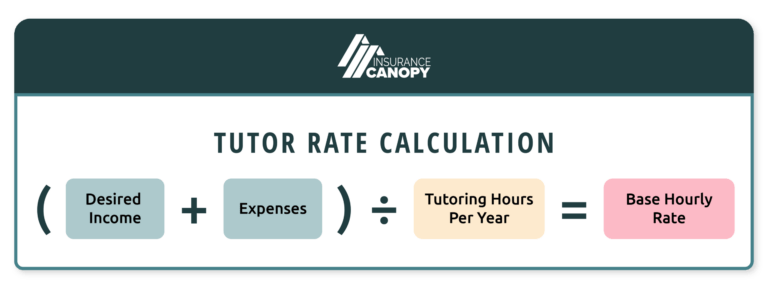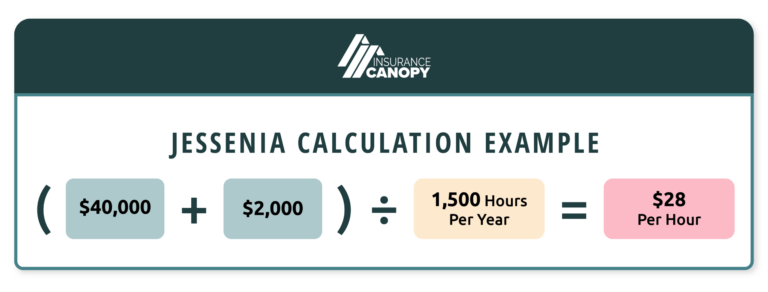“How much should I charge for tutoring?”
It’s the question every tutor has asked themselves. The average tutor in the U.S. makes $24.21 per hour, but that rate isn’t right for everyone in this field.
Balancing the value of your services with client budgets and expectations is one of the biggest challenges you face. You don’t want to overcharge and miss out on clients because your services are too expensive, but you also need to make a profit and get paid fairly for your work.
Setting your rates doesn’t have to feel like rocket science, though. It all boils down to a three-step process you can follow that accounts for your tutoring capabilities, your local market, and the types of clients you serve.
1. Identify the Factors That Influence Your Rates
Your Experience and Credentials
If you’re just starting out, you should charge a lower rate than other tutors in your area with more experience. You aren’t able to point to testimonials and positive reviews as proof of your value to potential clients just yet, but what you can offer is a lower price than your competitors.
One exception to this might be if you have an advanced degree, certifications, or specialized knowledge in a certain field. For example, if you earned your Master’s degree in differential calculus but the other college-level math tutors in your area only have Bachelor’s degrees, you may be able to charge a higher rate than them.
As a general rule of thumb, though — the more tutoring experience and educational credentials you have, the more you can charge.
Which Subjects You Teach
According to ZipRecruiter, the highest-paid tutors typically specialize in these subjects:
- Graduate Management Admission Test (GMAT) prep ($210,000–$230,000 per year)
- Law School Admission Test (LSAT) prep ($48,000–$125,000 per year)
- Science ($48,500–$115,500 per year)
- High school social studies ($40,000–$100,000 per year)
- Graduate Record Examinations (GRE) prep ($43,500–$83,000 per year)
- English ($30,000–$82,000 per year)
- American Bankers Association (ABA) prep ($71,500–$79,500 per year)
- American College Testing (ACT) prep ($33,000–$68,500 per year)
Test prep is a lucrative subject for tutors. Clients aim for a specific score to get into a certain school or program and want to learn test-taking strategies that make it easier for them to hit that mark.
Plus, if you have a proven track record of students scoring well on standardized tests and reaching their goals, you can charge more for your services because you have proof that your instruction gets results. See how to become an SAT tutor if this interests you!
Your Location
As with any career, where you’re located impacts how much you should charge for tutoring. Certain factors like cost of living, number of schools or universities, and population density can all play a role in making one city more profitable than another.
Here are the highest-paying cities for tutors in the U.S.:
- Washington, D.C. ($34.78 per hour)
- New York, NY ($33.54 per hour)
- Chicago, IL ($27.87 per hour)
- South Webster, OH ($26.83 per hour)
- Jarbidge, NV ($26.83 per hour)
- Heavener, OK ($26.83 per hour)
- Brooklyn, NY ($25.64 per hour)
- Los Angeles, CA ($25.61 per hour)
- Atlanta, GA ($23.09 per hour)

Whether You Tutor In-Person or Online
Online tutoring offers more flexibility than in-person tutoring. You can teach from almost anywhere, so long as you have a good internet connection and a webcam. Plus, if you live in an area without a high demand for tutoring services, you can find clients all across the country (or maybe even the world!).
However, it’s worth noting that remote tutors typically charge lower rates than in-person tutors, with the average being $19 per hour in the U.S.
There are a few reasons for this discrepancy, such as:
- Increased competition: When you tutor remotely, you compete with people across the globe for clientele, which can force you to offer extremely competitive rates.
- Lack of personal connection: You can still foster connections with your clients as a remote tutor, but it’s often a little harder than if you were to meet with them regularly in person. As such, they may not want to pay as much for online sessions.
- Decreased overhead costs: Remote tutors don’t have to travel to each session or rent out a space the way an in-person tutor would, so they often incur fewer expenses. This allows you to offer lower rates to your clients.
Business Overhead + Cost of Supplies and Equipment
You need to know what your overhead costs are each year to identify your breakeven point, so your annual expenses inevitably affect how much you should charge for each session.
Below are a few examples of what many tutors’ expenses go towards each year.
Business Expenses
- Taxes
- Tutor insurance
- Tutor certification (such as through the National Tutoring Association)
Miscellaneous Expenses
- Commuting (gas, transit fares, and/or vehicle maintenance for in-person tutors)
- Rented tutoring space
- Video conferencing software (such as Zoom for online tutors)
Supplies
- Textbooks
- Test prep materials
- Flashcards
- Pencils, pens, and notebooks
- Planners
- Binders
- Folders
- Sticky notes
Equipment and Tech
- Laptop
- Smartphone
- Tablet
- Learning management system (LMS) apps like Google Classroom, Canvas, LearnDash, etc.
- Reliable WiFi connection
- Webcam (for online tutors)
Pro Tip: Save yourself the financial burden of replacing stolen or damaged tutoring gear! Add Equipment and Materials coverage (known as inland marine coverage) to your liability policy for just $2.17 per month.
Whether You Do Group or Private Sessions
For those wondering how much to charge for private tutoring, it’s normal to charge more for one-on-one sessions versus group sessions because your clients get more personalized time with you.
Group sessions allow you to fit more clients into the same span of time where you’d normally be working with just one. That means you can charge a discounted group rate but make more per hour than you would in a private session.
Your Clients’ Age
Tutors who work with older students can usually charge more than those who work with younger ones because they often need a higher level of education and more expertise. Tutoring a student in third-grade science requires less technical knowledge than tutoring an undergraduate studying organic chemistry.
If you tutor special needs students, you may be able to set higher rates despite your students’ age. On average, special needs tutors charge $26 per hour because the job requires specialized skills, and clients may expect you to have a degree in special education.

2. Set Your Rates
Decide on a Realistic Salary
Account for Additional Expenses
After that, factor in your additional costs for the year as best you can. This includes transportation expenses and tutoring insurance premiums, as well as money spent on educational software and other supplies needed to do your job.
Create a Sustainable Schedule
Crunch the Numbers

For example, Jessenia is an English language tutor in NYC. Based on the average hourly rate of tutors in her area plus her degree in teaching English as a second language, she wants to earn $40,000 a year with her tutoring business.
She estimates that her transportation and supply costs will add up to $2,000 annually, and she can work 30 hours per week and 50 weeks per year.
Her calculation would look like this:

3. Test Your Rates and Adjust Accordingly
Once you’ve set your rates, commit to them for a year and monitor how your tutoring business performs. If you retain so many clients it’s hard to find time in your schedule for all of them, that’s a good sign to raise your rates for new students.
On the other hand, if you’re struggling to attract clientele, it could be because your rates are too high. Reassess your financial goals and lower your rates slightly to see if that makes a difference.

How to Communicate a Rate Increase
If you stick with tutoring long enough, there comes a time when you need to raise your rates for all clients — not just new ones. This might be a cost of living adjustment, or maybe your business expenses increased because you invested in better teaching software or equipment.
No matter the reason, you have to be mindful of how you introduce this change to your existing clients. To make this transition easier for you and your clients, keep the following tips in mind:
- Give ample notice in writing: Clients won’t respond well if you spring a price increase on them without a courteous heads-up. Announce this change at least 90 days in advance via email before it takes effect so they have time to consider their options and financially prepare.
- Provide an honest explanation: Telling your clients exactly why you’re raising rates is crucial for maintaining their trust.
- Communicate your value: Don’t be afraid to reiterate what you bring to the table as a tutor, such as how many clients have successfully passed their tests or improved their grades with your help.
- Expect some resistance: Not everyone will respond favorably to this change, so be prepared to speak with clients who want more context behind the change or to express their concerns.
- Be flexible where possible: If a client expresses that they want to keep studying under you but can’t afford your new rates, consider whether you could keep their rate the same while reducing the scope of their sessions. For example, you might meet with them for just 30 minutes a week instead of an hour like you did before your rates changed.
Protect Your Earnings With Tutoring Insurance
Calculating the perfect rate to price tutoring services ensures you can make a profit while keeping your clients satisfied, allowing you to continue doing what you love for years to come!
But did you know the best way to protect your profits is by getting a comprehensive liability insurance policy? If a client of yours doesn’t pass their exam and blames you for poor instruction, tutoring insurance could help cover legal fees if you get hit with a lawsuit.
Being insured has other benefits for tutors, not the least of which is a boon to your reputation. Marketing yourself as an insured tutor demonstrates preparedness and professionalism to your clients, which could contribute to higher rates and increased earnings.
Learn more about why you should get insured before your next session and make the smart choice for your business!

JoAnne Hammer | Program Manager
JoAnne Hammer is the Program Manager for Insurance Canopy. She has held the prestigious Certified Insurance Counselor (CIC) designation since July 2004.
JoAnne understands that starting and operating a business takes a tremendous amount of time, dedication, and financial resources. She believes that insurance is the single best way to protect your investment, business, and personal assets.
JoAnne Hammer is the Program Manager for Insurance Canopy. She has held the prestigious Certified Insurance Counselor (CIC) designation since July 2004.
JoAnne understands that starting and operating a business takes a tremendous amount of time, dedication, and financial resources. She believes that insurance is the single best way to protect your investment, business, and personal assets.





